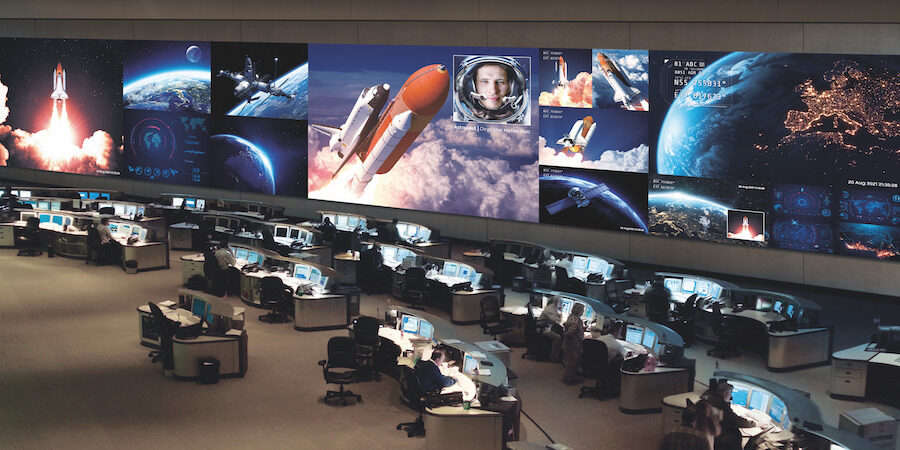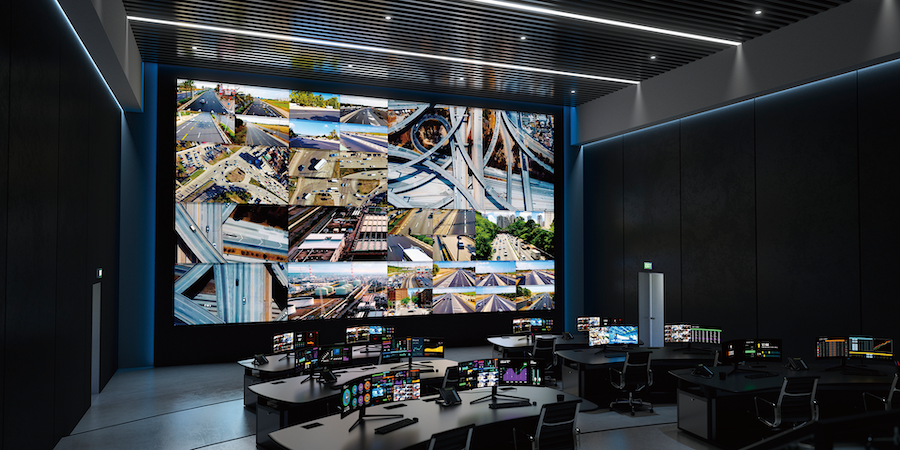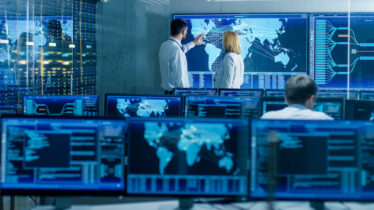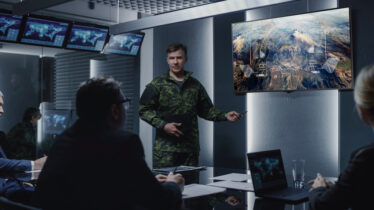Groundbreaking HDR visual display technology is finding a home in modern control rooms. Government agencies are increasingly adding video walls and high-resolution monitors to their command and control centers, the information hubs of emergency response teams. Where safety and security are paramount, lifelike color and heightened clarity aren’t just nice to have; they can improve rescue and response times in a crisis.
Control rooms rely on accurate and uninterrupted visuals to monitor crisis situations, dispatch response teams and coordinate those teams’ efforts. These hubs also organize critical ongoing activities such as air traffic and manufacturing. In applications like military and homeland security, command centers enable tactical operations and threat assessment. Law enforcement and public safety agencies also frequently use command and control centers for security and surveillance.
Having high-functioning, efficient control rooms is critical to their operations’ success and the safety of the population at large — and that’s where video walls, like Samsung’s The Wall, can make a world of difference.
Video wall integrations ensure 24/7 operation
To perform a range of emergency response functions, command and control operators need to meet a range of technological thresholds. They need critical information displayed rapidly and continuously, in an easily digestible format. And the supporting information systems need to be readily available, flexible and responsive. Command and control centers also need ongoing access to multiple information streams. It isn’t enough to hear from just one responder at one time, or to view a video from a single vantage point. Samsung’s video walls connect audio, video and other data streams drawn from across the incident, giving responders critical, real-time insight into an evolving situation.
Streamline agency operations with digital signage
Get your free guide to enhancing public safety and operational efficiency using digital signage. Download Now
Even in non-crisis streams, control room operators need to maintain constant vigilance. Samsung’s command center video wall solutions feature sophisticated cooling technology, allowing for 24/7 operation. And with picture-by-picture functionality, operators can view up to four content feeds at once. The extremely narrow bezel-to-bezel widths create visuals that are virtually seamless.
Scaling The Wall
The Wall has changed how seamless LED technology interacts with viewers, thanks to the unprecedented microLED technology behind the screen and its stunningly realistic visuals.
Here’s why The Wall stands alone:
- Secure and TAA-compliant: Government and federal organizations bound by strict security regulations can operate with peace of mind with The Wall, which is TAA-compliant. The Wall is also secured by Samsung Knox — a defense-grade security platform built in from the chip up, so you can rest assured your organization’s data will always be protected.
- 24/7 performance: In the modern control room, maximum uptime is often a matter of life or death. Disaster can strike at any moment, but The Wall features remote power operability. Even in unstable environmental situations, the command and control team can keep working uninterrupted.
- Detail and clarity: Millions of bright, microscopic LED lights comprise the screen’s crisp, precise visuals. With more accurate displays, command and control teams can take in the entire context of the situation at hand and make better-informed decisions.
- Optimal viewing: AI-powered algorithms and computing are built into The Wall’s display control system. This technology analyzes and adapts lower-resolution content in real time by populating additional pixels as needed. No matter the resolution, all on-screen visuals are enhanced to look sharp and clean, eliminating ambiguity in visuals that inform fundamental operations.
- True black: The Wall features Samsung’s Black Seal technology, which seals the pixels around a deep black background. Viewers get greater contrast and fewer reflections, which supports fast, efficient decision making. No longer do command and control centers have to be confined to dark rooms with minimal lighting and closed blinds. Even in direct sunlight, every detail of The Wall is visible.
- Long lifespan: On most direct view LED displays, the modular LEDs are exposed and at risk of damage from impact, moisture or static shock. The Wall is built resistant to these environmental threats, and the screen’s design disperses heat to prevent overheating. If someone bumps into it, there’s much less risk of damage — and less risk of downtime, which can be dangerous for control centers that require 24/7 operation. The Wall is a durable technology that command and control centers can depend on without worry.
- Ultimate flexibility: Not all command and control centers are built the same. Fortunately, The Wall can be customized to any size or shape, even wrapping around corners. To simplify the design and installation process, Samsung offers turnkey service and support. It’s easier than ever to configure The Wall exactly how you need it, lowering installation costs and reducing the need for on-site calibration.
The necessity of command center monitors
Aside from a video wall, operators require individual TAA-compliant monitors for a micro view of their data points, indicators and messaging. And this visual information must be displayed in accurate, true-to-life color. HDR10 and color reproduction technology in Samsung’s S Series monitors (S6, S7 and S8 Series) produces more than 1 billion colors in high contrast. Complemented with Flicker Free Technology, the S Series reduces eye strain, so operators can work long hours as necessary in comfort.
Widescreen monitors — or multiple monitors daisy chained together — make it easier for operators to multitask efficiently and keep up with ever-changing information. Samsung’s S95UA monitor has a built-in KVM switch, which lets operators use keyboard shortcuts to control multiple sources and toggle between apps with ease. A KVM switch and USB-C connectivity also remove the risks from fail-prone peripheral devices that may cause downtime in command center monitors and increase the workload for IT support staff.
Seamless technological integration
Today’s video walls integrate easily with a range of devices and data sources. The exponential growth of internet-connected devices has profound consequences for control centers. Just as video walls have taken control centers to a whole new level, the internet of things (IoT) has expanded this technology’s use cases.
Today’s vital, real-time content is increasingly being generated by internet-connected feeds rather than agents or responders in the field. Smart devices of all types now provide critical information and dynamic data that can be pulled directly onto a digital display. Networked sensors no longer have to wait for directions.
Once operators have defined the video scheme, the sensor feeds can autopopulate their assigned fields — delivering faster, more accurate information than has ever been possible. Sensors, cameras and other connected devices can move information in seconds, delivering it in whatever form the operator deems most helpful. But moving sensitive information between devices requires secure connections and military-grade protection.
With the readiness to embrace widespread connectivity, high-performance displays are positioned as the next measure of excellence in command and control centers. For their operators, these advances can be the difference between life and death.
Learn how to secure your government display technology against the latest cyber threats using this free guide. If a video wall doesn’t fit your budget right now, explore Samsung’s innovative range of smaller digital displays.








